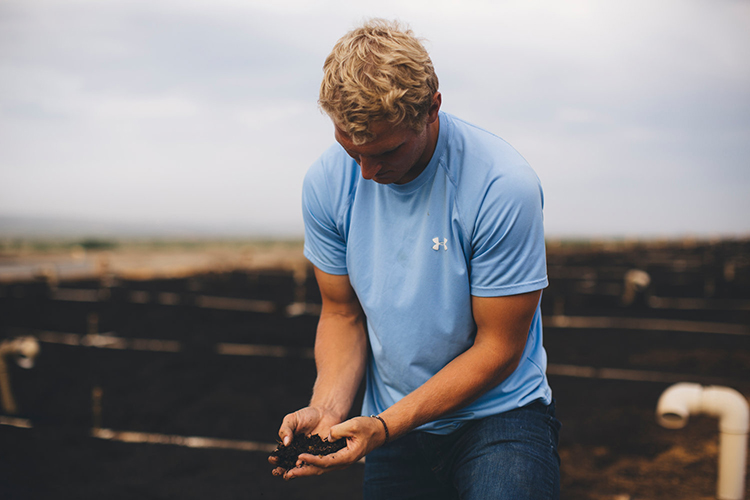“Closing the loop” of food production is the goal at Royal Dairy in Royal City, Wash., and Austin Allred has implemented industry-leading tools that are allowing him to do just that while building a more regenerative operation.
The loop encompasses the farm’s 6,500 milking cows, Angus crossbreds they raise to maturity and market, the manure and wastewater from caring for those animals, and 5,000 acres of crops for the herd plus his dad’s potato, apple, and cherry farm. The tools that connect all of those enterprises include consumer friendly food traceability, carbon footprint calculation, healthy soil practices and fertilization, and water recycling.
From carbon to consumer
Allred described that the Angus-dairy crossbred calves close the loop on the dairy production side. Another part of the supply chain is filled by the family’s brand, Royal Ranch, marketing the beef. But that’s not all — Allred’s regenerative outlook is reflected in the information a consumer can access about their food as soon as they pick it up.
“When somebody buys our meat, they can scan a barcode and it’ll pull up how much food an animal ate, how much carbon was sequestered in the growing of those crops, and the emissions that animal emitted,” Allred explained about the service they connect with their beef, Farm Tracer. The family’s apples and cherries are also tracked through the program. “At the end of the day, all of that information is telling us that all of our animals, to date, from Royal Ranch are carbon negative.”
That data is made possible because the farm monitors all crop inputs and reports the conservation practices they use, such as reduced tillage, into a program developed by USDA and Colorado State University called COMET-Farm. The system then calculates the carbon footprint of the farm’s crop production.
Cleaner, recycled water
Allred knew that the whole systems approach didn’t just encompass the animals and land of the farm, so a few years ago, they began testing a water treatment system that harnesses the power of worm digestion to create two valuable products — clean water and nutrient-rich compost — from excess water.
“Like every dairy, we had a lot of green water that was, frankly, the highest liability on our farm,” Allred explained. The solution they found is a 5-foot-deep pit modeled after how water is cleaned naturally in the ground. The top 3 feet of the system consist of wood chips, and below that is a foot and a half of rocks. All of the farm’s water comes out on the top of the pit, where it settles through the wood chips and then the rocks before being reclaimed at the bottom to be used as irrigation water.
Worms in the wood chips eat the nutrients filtered out of the water, and their digestion makes valuable compost that’s also able to be applied to the fields. These worm castings are much higher in nitrogen than dairy manure, and Allred says the compost is about seven times more valuable than manure.
All about the system
As with any tool that monitors data, it can be difficult to establish a baseline and know the information being recorded is accurate, and Allred says that has been the most challenging part of the additions to his farm. But the value these programs bring in helping the farm operate more self-sufficiently is allowing him to reach his visions of the future of farming and a more connected local ecosystem.
“The model we’re following is regenerative ag, and we’re trying to get to regenerative ag at a real scale,” he said. “Our soils are the solution. As we use ruminants, and in our case, worms, and their God-given digestive systems, we will be so much more effective at sequestering and banking carbon, which is going to make them better soils with more organic matter, more efficient and productive, and less reliant on the different synthetics we currently feed our soil.”
He continued, “I see the ruminant being a major part of the answer to help our soils.”
Allred will be sharing more about his farm’s practices in a presentation at this year’s Connect Summit, June 15 to 17 in Nashville, Tenn. Registration for the conference, which will highlight advances and opportunities for data and technology usage in dairy production, is open now. You can also learn more by following Royal Family Farming on Facebook and Instagram.









